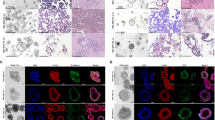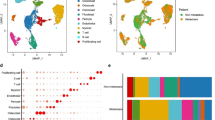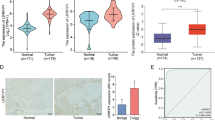Abstract
The overwhelming majority of pancreatic ductal adenocarcinoma (PDAC) is not diagnosed until the cancer has metastasized, leading to an abysmal average life expectancy (3–6 months post-diagnosis). Earlier detection and more effective treatments have been hampered by inadequate understanding of the underlying molecular mechanisms controlling metastasis. We hypothesized that metastasis suppressors are involved in controlling metastasis in pancreatic cancer. Using an unbiased genome-wide shRNA screen, an shRNA library was transduced into the non-metastatic PDAC line S2-028 followed by intrasplenic injection. Resulting liver metastases were individually isolated from these mice. One liver metastatic nodule contained shRNA for ITIH5 (Inter-alpha-trypsin inhibitor heavy chain 5), suggesting that ITIH5 may act as a metastasis suppressor. Consistent with this notion, metastatic PDAC cell lines had significantly lower protein expression of ITIH5 compared to immortalized pancreatic ductal epithelial cells and non-/poorly-metastatic PDAC cell lines. By manipulating expression of ITIH5 in different PDAC cell lines (over-expression in metastatic, knockdown in non-metastatic) functional and selective regulation of metastasis was observed for ITIH5. Orthotopic tumor growth of PDAC cells was not blocked following orthotopic injection. In vitro ITIH5 over-expression inhibited motility and invasion. Immunohistochemical analysis of a human PDAC tissue microarray revealed that ITIH5 expression inversely correlated with both survival and invasion/metastasis. ITIH5 is, therefore, functionally validated as a PDAC metastasis suppressor and shows promise as a prognostic biomarker.






Similar content being viewed by others
Abbreviations
- RNAi:
-
RNA interference
- PDAC:
-
Pancreatic ductal adenocarcinoma
- shRNA:
-
Short hairpin RNA
- ITIH5:
-
Inter-alpha-trypsin inhibitor heavy chain 5
- HMP19:
-
Hypothalamus Golgi apparatus expressed 19 kDa protein
- HPNE:
-
Human pancreatic duct normal epithelium cells
- FBS:
-
Fetal bovine serum
- shRNAmir:
-
MicroRNA-adapted shRNA
- ITIs:
-
Inter-α-trypsin inhibitors
- ITIHs:
-
ITI heavy chains
- HA:
-
Hyaluronic acid
- SHAP:
-
Serum-derived hyaluronic acid-associated protein
References
Vincent A, Herman J, Schulick R, Hruban RH, Goggins M (2011) Pancreatic cancer. The Lancet 378(9791):607–620
Rahib L, Smith BD, Aizenberg R, Rosenzweig AB, Fleshman JM, Matrisian LM (2014) Projecting cancer incidence and deaths to 2030: the unexpected burden of thyroid, liver, and pancreas cancers in the United States. Cancer Res 74(11):2913–2921
Cameron JL, Riall TS, Coleman J, Belcher KA (2006) One thousand consecutive pancreaticoduodenectomies. Annals of surgery 244:10–15
Liu W, Vivian CJ, Brinker AE, Hampton KR, Lianidou E, Welch DR (2014) Microenvironmental influences on metastasis suppressor expression and function during a metastatic cell’s journey. Cancer Microenviron 7(3):117–131
Bohl CR, Harihar S, Denning WL, Sharma R, Welch DR (2013) Metastasis suppressors in breast cancers: mechanistic insights and clinical potential. J Mol Med 92(1):13–30
Hurst DR, Welch DR (2011) Metastasis suppressor genes: at the interface between the environment and tumor cell growth. Intl Rev Cell Molec Biol 286:107–80
Lee J-H, Miele ME, Hicks DJ et al (1996) KiSS-1, a novel human malignant melanoma metastasis-suppressor gene. J Natl Cancer Inst 88(23):1731–1737
Dong JT, Lamb PW, Rinker-Schaeffer CW et al (1995) KAI1, a metastasis suppressor gene for prostate cancer on human chromosome 11p11.2. Science 268(5212):884–886
Guo XZ, Friess H, Shao XD et al (2000) KAI1 gene is differently expressed in papillary and pancreatic cancer: influence on metastasis. World J Gastroenterol 6(6):866–871
McNally LR, Welch DR, Beck BH et al (2010) KISS1 over-expression suppresses metastasis of pancreatic adenocarcinoma in a xenograft mouse model. Clin Exptl Metastasis 27(8):591–600
Gumireddy K, Li AP, Gimotty PA et al (2009) KLF17 is a negative regulator of epithelial-mesenchymal transition and metastasis in breast cancer. Nature Cell Biol 11(11):1297–U69
Murugaesu N, Iravani M, van WA et al (2014) An in vivo functional screen identifies ST6GalNAc2 sialyltransferase as a breast cancer metastasis suppressor. Cancer Discov 4(3):304–17
Duquet A, Melotti A, Mishra S et al (2014) A novel genome-wide in vivo screen for metastatic suppressors in human colon cancer identifies the positive WNT-TCF pathway modulators TMED3 and SOX12. EMBO Mol Med 6(7):882–901
Giavazzi R, Jessup JM, Campbell DE, Walker SM, Fidler IJ (1986) Experimental nude mouse model of human colorectal cancer liver metastases. J Natl Cancer Inst 77(6):1303–1308
Giavazzi R, Campbell DE, Jessup JM, Cleary KR, Fidler IJ (1986) Metastatic behavior of tumor cells isolated from primary and metastatic human colorectal carcinomas implanted into different sites of nude mice. Cancer Res 46(4):1928–1933
Vonlaufen A, Joshi S, Qu CF et al (2008) Pancreatic stellate cells: partners in crime with pancreatic cancer cells. Cancer Res 68(7):2085–2093
Gospodarowicz MK, Miller D, Groome PA, Greene FL, Logan PA, Sobin LH (2004) The process for continuous improvement of the TNM classification. Cancer 100(1):1–5
Sobin LH (2003) TNM, sixth edition: new developments in general concepts and rules. Semin Surg Oncol 21(1):19–22
Kurahara H, Bohl C, Natsugoe S et al (2016) Suppression of pancreatic cancer growth and metastasis by HMP19 identified through genome-wide shRNA screen. Int J Cancer 139(3):628–638
Kobayashi H, Fujie M, Shinohara H, Ohi H, Sugimura M, Terao T (1994) Effects of urinary trypsin inhibitor on the invasion of reconstituted basement membranes by ovarian cancer cells. Int J Cancer 57(3):378–384
Kobayashi H, Shinohara H, Fujie M et al (1995) Inhibition of metastasis of Lewis lung carcinoma by urinary trypsin inhibitor in experimental and spontaneous metastasis models. Int J Cancer 63(3):455–462
Huang L, Yoneda M, Kimata K (1993) A serum-derived hyaluronan-associated protein (SHAP) is the heavy chain of the inter alpha-trypsin inhibitor. J Biol Chem 268(35):26725–26730
Chen L, Mao SJ, McLean LR, Powers RW, Larsen WJ (1994) Proteins of the inter-alpha-trypsin inhibitor family stabilize the cumulus extracellular matrix through their direct binding with hyaluronic acid. J Biol Chem 269(45):28282–28287
Zhuo L, Kimata K (2008) Structure and function of inter-alpha-trypsin inhibitor heavy chains. Connect Tissue Res 49(5):311–320
Subrungruanga I, Thawornkunob C, Chawalitchewinkoon-Petmitrc P, Pairojkul C, Wongkham S, Petmitrb S (2013) Gene expression profiling of intrahepatic cholangiocarcinoma. Asian Pac J Cancer Prev 14(1):557–563
Hamm A, Veeck J, Bektas N et al (2008) Frequent expression loss of Inter-alpha-trypsin inhibitor heavy chain (ITIH) genes in multiple human solid tumors: a systematic expression analysis. BMC Cancer 8:25
Abdullah-Soheimi SS, Lim BK, Hashim OH, Shuib AS (2010) Patients with ovarian carcinoma excrete different altered levels of urine CD59, kininogen-1 and fragments of inter-alpha-trypsin inhibitor heavy chain H4 and albumin. Proteome Sci 8:58
Paris S, Sesboue R, Delpech B et al (2002) Inhibition of tumor growth and metastatic spreading by overexpression of inter-alpha-trypsin inhibitor family chains. Int J Cancer 97(5):615–620
Himmelfarb M, Klopocki E, Grube S et al (2004) ITIH5, a novel member of the inter-alpha-trypsin inhibitor heavy chain family is downregulated in breast cancer. Cancer Lett 204(1):69–77
Veeck J, Chorovicer M, Naami A et al (2008) The extracellular matrix protein ITIH5 is a novel prognostic marker in invasive node-negative breast cancer and its aberrant expression is caused by promoter hypermethylation. Oncogene 27(6):865–876
Kloten V, Becker B, Winner K et al (2013) Promoter hypermethylation of the tumor-suppressor genes ITIH5, DKK3, and RASSF1A as novel biomarkers for blood-based breast cancer screening. Breast Cancer Res 15(1):R4
Oing C, Jost E, Dahl E, Wilop S, Brummendorf TH, Galm O (2011) Aberrant DNA hypermethylation of the ITIH5 tumor suppressor gene in acute myeloid leukemia. Clin Epigenetics 2(2):419–423
Zhang S, Feng XL, Shi L et al (2013) Genome-wide analysis of DNA methylation in tongue squamous cell carcinoma. Oncol Rep 29(5):1819–1826
Rose M, Gaisa NT, Antony P et al (2014) Epigenetic inactivation of ITIH5 promotes bladder cancer progression and predicts early relapse of pT1 high-grade urothelial tumours. Carcinogenesis 35(3):727–736
Kloten V, Rose M, Kaspar S, von SS, Knuchel R, Dahl E (2014) Epigenetic inactivation of the novel candidate tumor suppressor gene ITIH5 in colon cancer predicts unfavorable overall survival in the CpG island methylator phenotype. Epigenetics 9(9):1290–1301
Mai C, Zhao JJ, Tang XF et al (2014) Decreased ITIH5 expression is associated with poor prognosis in primary gastric cancer. Med Oncol 31(7):53
Pita JM, Banito A, Cavaco BM, Leite V (2009) Gene expression profiling associated with the progression to poorly differentiated thyroid carcinomas. Br J Cancer 101(10):1782–1791
Acknowledgements
The authors are extremely grateful to Dr. Tony Hollingsworth (Eppley Cancer Center) for the gift of the SUIT-2 cell lines and appreciate helpful advice from Drs. Animesh Dhar, Shrikant Anant and Dan Von Hoff. They thank Dr. Christopher Bohl and Carolyn Vivian for technical assistance and other members of our labs for thoughtful suggestions and advice from the University of Kansas Cancer Center Biostatistics Shared Resource. DRW is the Hall Family Professor of Molecular Medicine, a Kansas Bioscience Authority Eminent Scholar and a Komen Scholar. The authors also thank the funding agencies who supported this research.
Funding
These studies were funded primarily by a grant from the National Foundation for Cancer Research (DRW), with additional support from U.S. Public Health Service grants CA134981 (DRW), CA168524 (DRW) and CA174735 (TI), the American Cancer Society (RSG-09-169-01-CS to TI), Susan G. Komen for the Cure SAC11037 (DRW) and The Kansas Biosciences Authority (DRW).
Author information
Authors and Affiliations
Corresponding authors
Ethics declarations
Conflict of interest
The authors declare no conflict of interest.
Rights and permissions
About this article
Cite this article
Sasaki, K., Kurahara, H., Young, E.D. et al. Genome-wide in vivo RNAi screen identifies ITIH5 as a metastasis suppressor in pancreatic cancer. Clin Exp Metastasis 34, 229–239 (2017). https://doi.org/10.1007/s10585-017-9840-3
Received:
Accepted:
Published:
Issue Date:
DOI: https://doi.org/10.1007/s10585-017-9840-3




